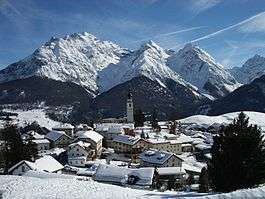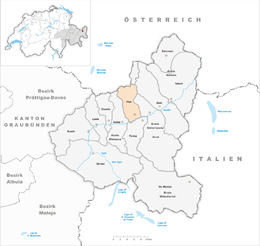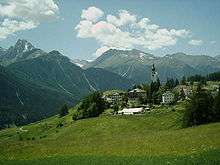Ftan
| Ftan | ||
|---|---|---|
| Former municipality of Switzerland | ||
 | ||
| ||
 Ftan  Ftan | ||
|
Location of Ftan  | ||
| Coordinates: 46°47′N 10°14′E / 46.783°N 10.233°ECoordinates: 46°47′N 10°14′E / 46.783°N 10.233°E | ||
| Country | Switzerland | |
| Canton | Graubünden | |
| District | Inn | |
| Area | ||
| • Total | 43.11 km2 (16.64 sq mi) | |
| Elevation | 1,648 m (5,407 ft) | |
| Population (Dec 2014) | ||
| • Total | 492 | |
| • Density | 11/km2 (30/sq mi) | |
| Postal code | 7551 | |
| SFOS number | 3761 | |
| Surrounded by | Ardez, Galtür (AT-7), Ramosch, Scuol, Sent, Tarasp | |
| Website |
www SFSO statistics | |
Ftan is a former municipality in the district of Inn in the Swiss canton of Graubünden. On 1 January 2015 the former municipalities of Ardez, Guarda, Tarasp, Ftan and Sent merged into the municipality of Scuol.[1]
History
Ftan is first mentioned in 1150 as Vetane.[2]
Geography

Ftan had an area, as of 2006, of 43.1 km2 (16.6 sq mi). Of this area, 40.6% is used for agricultural purposes, while 15.4% is forested. Of the rest of the land, 1.2% is settled (buildings or roads) and the remainder (42.8%) is non-productive (rivers, glaciers or mountains).[3]
The former municipality is located in the Suot Tasna sub-district of the Inn district on a terrace above the left bank of the Inn river. It consists of the village sections of Ftan Grond and Ftan Pitschen. Until 1943 Ftan was known as Fetan.[4]
Demographics
Ftan had a population (as of 2014) of 492. As of 2008, 11.2% of the population was made up of foreign nationals.[5] Over the last 10 years the population has grown at a rate of 9.6%.[3]
As of 2000, the gender distribution of the population was 49.2% male and 50.8% female.[6] The age distribution, as of 2000, in Ftan is; 57 children or 11.0% of the population are between 0 and 9 years old. 40 teenagers or 7.8% are 10 to 14, and 84 teenagers or 16.3% are 15 to 19. Of the adult population, 39 people or 7.6% of the population are between 20 and 29 years old. 65 people or 12.6% are 30 to 39, 69 people or 13.4% are 40 to 49, and 53 people or 10.3% are 50 to 59. The senior population distribution is 43 people or 8.3% of the population are between 60 and 69 years old, 48 people or 9.3% are 70 to 79, there are 15 people or 2.9% who are 80 to 89, and there are 3 people or 0.6% who are 90 to 99.[5]
In the 2007 federal election the most popular party was the SVP which received 43% of the vote. The next three most popular parties were the SPS (42.1%), the FDP (7.7%) and the CVP (5.1%).[3]
In Ftan about 81.8% of the population (between age 25-64) have completed either non-mandatory upper secondary education or additional higher education (either university or a Fachhochschule).[3]
Ftan has an unemployment rate of 0.81%. As of 2005, there were 64 people employed in the primary economic sector and about 24 businesses involved in this sector. 16 people are employed in the secondary sector and there are 6 businesses in this sector. 180 people are employed in the tertiary sector, with 25 businesses in this sector.[3]
The historical population is given in the following table:[2]
| year | population |
|---|---|
| 1835 | 538 |
| 1850 | 506 |
| 1900 | 403 |
| 1950 | 504 |
| 1970 | 425 |
| 2000 | 516 |
Languages
Most of the population (as of 2000) speaks Rhaeto-Romance (57.8%), with German being second most common (37.0%) and Italian being third ( 1.2%).[3]
| Languages in Ftan | ||||||
| Languages | Census 1980 | Census 1990 | Census 2000 | |||
| Number | Percent | Number | Percent | Number | Percent | |
| German | 139 | 31.95% | 153 | 33.77% | 191 | 37.02% |
| Romansh | 251 | 57.70% | 263 | 58.06% | 298 | 57.75% |
| Italian | 19 | 4.37% | 14 | 3.09% | 6 | 1.16% |
| Population | 435 | 100% | 453 | 100% | 516 | 100% |
References
- ↑ Amtliches Gemeindeverzeichnis der Schweiz published by the Swiss Federal Statistical Office (in German) accessed 27 April 2016
- 1 2 Ftan in German, French and Italian in the online Historical Dictionary of Switzerland.
- 1 2 3 4 5 6 Swiss Federal Statistical Office Archived January 5, 2016, at the Wayback Machine. accessed 12-Oct-2009
- ↑ Amtliches Gemeindeverzeichnis der Schweiz published by the Swiss Federal Statistical Office (in German) accessed 23 September 2009
- 1 2 Graubunden Population Statistics Archived August 27, 2009, at the Wayback Machine. (in German) accessed 21 September 2009
- ↑ Graubunden in Numbers Archived September 24, 2009, at the Wayback Machine. (in German) accessed 21 September 2009
| Wikimedia Commons has media related to Ftan. |
